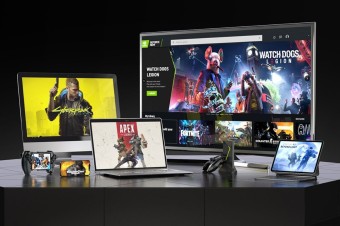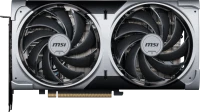NVIDIA GeForce RTX 50: meet the next-generation graphics cards
We independently test the products and technologies that we recommend.

1. Which video cards are included in the RTX 50 series?

NVIDIA's most current architecture, Ada Lovelace, was introduced back in 2022, and since then NVIDIA has only adjusted prices and updated the RTX 4000 line with new modifications of video cards with the Ti and SUPER prefixes. Rumors about a new generation of video cards have been circulating since the fall of 2024, until NVIDIA CEO Jensen Huang finally unveiled the new products at CES 2025. They came out under the codename Blackwell and received several long-awaited updates, including GDDR7 memory and DLSS 4.0 support.
Key features of GeForce RTX 50 graphics cards:
- Blackwell Architecture
- DLSS 4.0
- GDDR7 memory
- Supports PCIe Gen 5 and DisplayPort 2.1b
Traditionally, the most powerful representatives of the new series will go on sale at the start - RTX 5090 and RTX 5080, as well as moderately powerful RTX 5070 and RTX 5070 Ti. It is logical to assume that a little later NVIDIA will introduce more affordable options: RTX 5060, RTX 5060 Ti and, possibly, RTX 5050.
Specifications and prices:
- GeForce RTX 5070: 6,144 CUDA cores, 12 GB GDDR7 memory (192-bits bus width). MSRP: $549.
- GeForce RTX 5070 Ti: 8,960 CUDA cores, 16 GB of GDDR7 memory (256-bits). MSRP: $749.
- GeForce RTX 5080: 10,752 CUDA cores, 16 GB of GDDR7 memory (256-bits). MSRP: $999.
- GeForce RTX 5090: 21,760 CUDA cores, 32 GB of GDDR7 memory (512-bits). The price is $1999, not $2000 as many experts predicted. By the way, the RTX 5090 in the Founders Edition will take up 2 slots on the motherboard and is suitable for use in compact cases.

As we can see, compared to the previous generation, the memory capacity has increased only for the flagship RTX 5090 (the RTX 4090 had 24 GB), and the price tag of about $2000 is becoming the norm for NVIDIA. After the crisis in the semiconductor market, the company is doing so well that you couldn’t imagine anything better, and it seems that the times of the people’s GeForce GTX 1050 and GTX 1650 have finally and irrevocably passed.

NVIDIA also officially announced the GeForce RTX 50 series of video cards for laptops, which are essentially simplified and more energy-efficient variations of older desktop video accelerators.
2. Getting to know the Blackwell architecture

Before getting acquainted with the flow Rate of the new products, we suggest quickly going over the innovations of the Blackwell architecture and the differences from Ada Lovelace.
Chiplet structure: Blackwell uses a modular design with two compute chiplets containing a total of 104 billion transistors and eight HBM3E memory chiplets. These components are combined using TSMC's CoWoS-L packaging technology, which on the one hand leads to increased flow Rate per watt, but on the other hand makes it more difficult to test new chips.
New Memory: Blackwell-based graphics cards feature new GDDR7 memory with a higher bits depth and higher bandwidth than GDDR6. For example, the flagship RTX 5090's memory runs at 28 Gbps, delivering 1.8 TB/s of bandwidth.
Improved Tensor Cores: Blackwell introduces fifth-generation Tensor Cores that support new FP4 and FP6 data formats. NVIDIA says that using 4-bits data enables greater efficiency and throughput when inferring models for generative AI training.

NV-HBI Interconnect: Blackwell uses a new proprietary NV-HBI (NVIDIA High Bandwidth Interface) for communication between chiplets, providing throughput of up to 10 TB/s. According to NVIDIA CEO Jensen Huang, the development of NV-HBI cost the company $10 billion.
3. Learn more about DLSS 4.0

There are different attitudes towards upscaling and frame generation. On the one hand, DLSS can significantly increase the overall FPS in games, and the image quality is often better than with TAA antialiasing. And a free analogue of DLSS called AMD FSR can even breathe new life into outdated video cards like the Radeon RX 580 and GeForce GTX 1050. On the other hand, the widespread use of DLSS and FSR has complicated the testing of purebred video card power and made life easier for game developers, many of whom have stopped caring about optimization. In any case, this topic is with us seriously and for a long time, so it is not surprising that the announcement of DLSS 4.0 became almost the most discussed topic of the presentation.
So, the most interesting innovation of DLSS 4 was the new Multi Frame Generation technology, capable of generating up to three additional frames per one actually rendered frame. DLSS 3.0 worked according to the scheme "one rendered frame + one generated". At the presentation, Jensen Huang said that DLSS 4 can increase the gaming flow Rate of new video cards by 8 times compared to classic rendering.
NVIDIA says the old method of using convolutional neural networks has reached its limits, so DLSS 4 uses a transformer architecture in the style of ChatGPT, Flux, and Gemini. This allows the new DLSS model to use twice the amount of data to analyze a frame and can more accurately determine the importance of each pixel in a frame. NVIDIA says that by changing the AI, it has been able to improve the quality of anti-aliasing while reducing ghosting, motion blur, and other visual artifacts that occur during upscaling and frame generation.
Ray Reconstruction (RR) is a key innovation in DLSS, first introduced in DLSS 3.5 and significantly improved in DLSS 4.0. It replaces traditional denoising techniques to improve the quality of ray tracing in real time. Instead of static filters that can result in loss of detail and blur, RR dynamically analyzes data in each frame, including textures, materials, and lights.
All GeForce RTX graphics cards of different generations received DLSS 4 support in one form or another, but Multi Frame Generation technology will only work with Blackwell graphics cards. As for games, NVIDIA has already promised to implement DLSS 4 in 75 games in the near future, including Alan Wake 2, Cyberpunk 2077, Black Myth: Wukong and Marvel Rivals.
4. What about flow Rate?

Now let's move on to the most difficult and slippery question. The only flow Rate tests that exist at the moment are the figures from NVIDIA itself, so it's better to take them with a grain of salt. According to NVIDIA, thanks to the new Blackwell architecture and DLSS 4, the RTX 5090 provides twice the flow Rate of the RTX 4090. In Cyberpunk 2077 with full ray tracing enabled, the RTX 5090 with DLSS 4 delivers an average of 238 FPS, while its predecessor, the RTX 4090 with DLSS 3.5, delivers an average of 106 FPS. At the same time, the power consumption of the new product has increased by 125 W, and NVIDIA recommends a PSU with a capacity of at least 1000 W to power the entire system.

In the basic mode, the pre-top RTX 5080 is not that much ahead of the RTX 4080. But in the multi-frame generation mode and with ray tracing enabled, gamers are promised an almost two-card flow Rate increase. The total card power is 360 W, and the minimum recommended power supply is 850 W.

As for the RTX 5070 Ti and RTX 5070, they should also be twice as powerful as their predecessors, the RTX 4070 Ti and RTX 4070. NVIDIA put a special emphasis on the RTX 5070, saying that it will provide RTX 4090-level flow Rate for $549. However, such an increase is unlikely to be achieved through pure rasterization, but rather thanks to DLSS 4, which significantly optimizes graphics processing. And this is perhaps the most controversial point of the presentation, which gave rise to a lot of memes.
5. Conclusion

NVIDIA's presentation has traditionally divided people into two camps, with some praising the new products and others criticizing NVIDIA for high prices and shifting focus from the pure flow Rate of new video cards to an artificial increase in flow Rate due to DLSS 4 and redrawn frames. Many also criticize the company for being stingy with video memory - yes, on the one hand, there was a long-awaited transition to GDDR7, on the other hand, all new products except the flagship RTX 5090 have the same amount of memory as the previous generation. In general, NVIDIA knows how to make a splash in its own style, and it is not surprising that even Huang's new jacket is discussed more often online than the Radeon RX 9070 XT presented at CES 2025. In any case, only independent tests will show the real difference in flow Rate, and it won't be long before that happens. Then we will find out to what extent sellers will follow the recommended prices.
Articles, reviews, useful tips
All materials






























































































